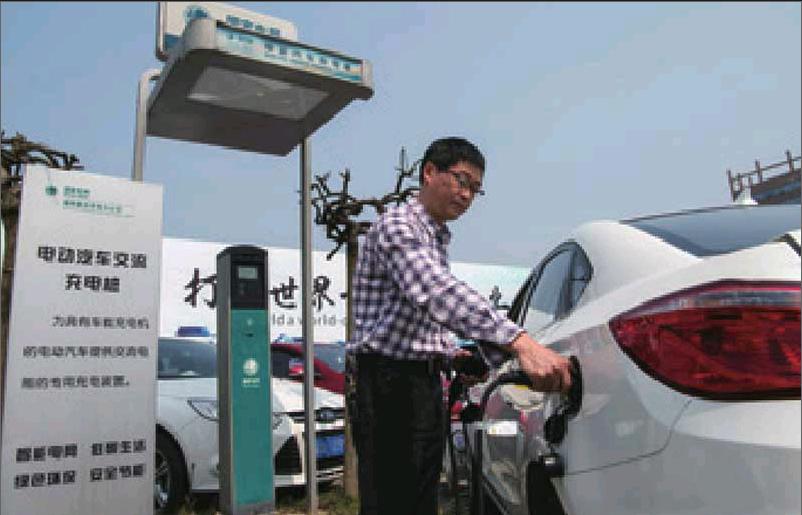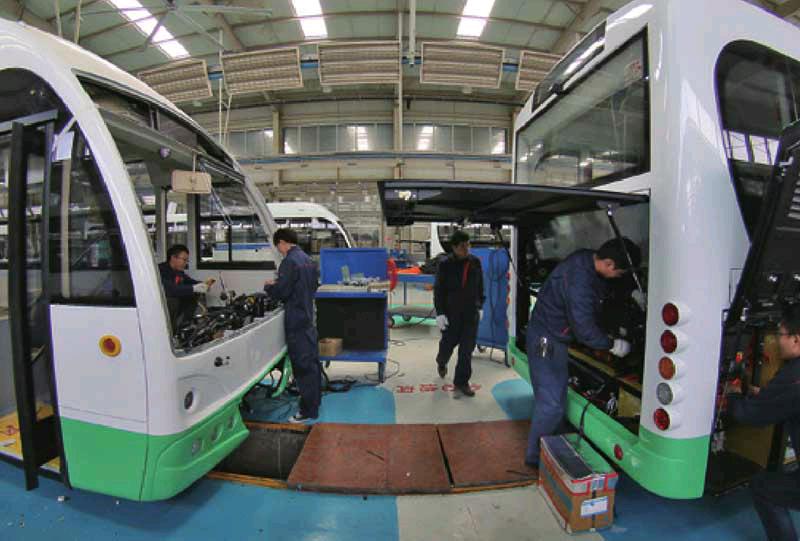Fueled up Faster and Further
2016-04-27ByWangJun
By+Wang+Jun


The electric vehicle (EV) industry was recently shaken up by news from Tesla Motors as it unveiled its Model 3 on March 31. The new car, which touts a range of 344 km per charge, hails a new era of affordable EVs within the reach of ordinary consumers.
Even so, EVs are not yet commonplace, mainly due to two reasons: high prices and poor battery range.
Ultimately, innovations in battery technology are expected to solve the problem of poor range and help lower EV prices. But how soon can these new batteries be expected to enter the market, and how far can EVs run in the future?
Slow charge, low range
The lengthy charging process and the limited range that these vehicles can reach are major obstacles restricting the development of newenergy cars.
Slow charging an EVs battery takes six to eight hours to fully charge. On the other hand, quick charging takes only one and a half hours, but only charges 80 percent of the battery.
“I have battery anxiety,” Wang Qiang, an electric car driver in Beijing, told Xinhua News Agency. “While driving the car I will start to wonder whether the battery can last long enough to make the drive home, and whether there are charging stations nearby.”
It takes Wang one and a half hours to charge his car via quick charging, after which he can drive for 160 km. Nonetheless, he still has to wait a long time before he can use the charging station, highlighting the lack of ease that EVs are encumbered with compared to conventional cars.
Shoring up confidence and a reputation for reliability remains a monumental task for this nascent industry. How can these manufacturers ease their consumers anxieties?
The immediate solution would be to build more charging facilities. In October 2015, the National Development and Reform Commission, the National Energy Administration, the Ministry of Industry and Information Technology and the Ministry of Housing and Urban-Rural Development jointly issued a set of guidelines for developing EV charging facilities in China throughout 2015-20. They required the construction of 12,000 charging stations and 4.8 million charging stations nationwide to meet the demand of the 5 million electric cars operating in the country.
Although the news is a boon to EV owners, constructing more charging facilities cannot solve the underlying inconvenience caused by slow charging. A revolution in battery technology that would allow EVs to be charged as quickly as traditional cars can be filled with fuel would be the holy grail of energy solutions. EVs can only demonstrate superiority over gasoline vehicles once this problem is surmounted.
“To run father, EVs must have greater energy storage capabilities. And to be charged more quickly, EVs must have a higher power density capacity,” said Li Hong, chief scientist for the research group of high-energy-density lithium batteries at the Chinese Academy of Sciences (CAS), adding that improving a batterys energy density is of fundamental importance to EV performance.
Li told Xinhua that Chinese EV manufacturers now use lithium batteries with an energy density of about 180 watts an hour per kilogram, with a range of 200 km per charge. “In the next few years the goal of the industry is to improve the energy density to 300-400 watts an hour per kilogram,” he said. “And with other improvements, their range can reach 470-628 km per charge, capable of competing with gasoline vehicles.”
Chen Xiaojiang, Deputy Director of the Passenger Vehicle Design Institute of Beiqi Foton Motor Co. Ltd., said that major world EV makers might be able to produce electric cars with ranges of 400-500 km by 2018. By that time, Chen claimed that the battery perfor-mance will be enhanced and that prices would therefore be reduced significantly.
Case in point, last year, Audi announced that it will present its first all-electric SUV with a range of more than 500 km in 2018.
Challenges and opportunities
The new-energy vehicle industry is one that many countries and automakers have attempted to tap into. “EVs will create more opportunities than conventional gas-powered cars,” said Liu Su, head of the System Development Department of Beiqi Fotons NewEnergy Technology Center.
In China, battery anxieties and other problems regarding EVs have received attention from the government, researchers and automakers.
The “Made in China 2025” plan issued last year, which aims to strengthen the manufacturing prowess of the worlds second largest economy, mandated the improvement of the EV power battery system and new-material battery technologies, as well as pledged greater government support to the new-energy vehicle industry.
Among the five supportive measures decided at the State Council Executive Meeting on February 24, the first is to accelerate breakthroughs in battery technology.
The government will encourage enterprises, universities and research institutes to set up innovation platforms centered on the research and development of batteries, according to a statement released after the meeting.
“We hope to produce high-performance batteries with China-made materials and equipment,” Li said. According to him, the CAS has started research programs to produce more efficient and safer “ultimate batteries” by changing liquid electrolytes into solid electrolytes in lithium-air batteries.
Batteries will be a very important factor in a future shaped by a new-energy revolution.“China is in a favorable position in this aspect, and may become a leader in the future,” Li noted.
Chinese researchers have filed 47 percent of all papers on lithium batteries submitted to the Science Citation Index, an internationally acknowledged database, ranking first in the world.
China also has a complete industrial chain, which means it doesnt need to import anything from other countries to produce lithium batteries. Some Chinese companies have therefore developed cutting-edge technologies such as high-energy-density lithium batteries, and are producing them for foreign EV manufacturers.
“There are more than 1,000 members in our battery research and development team, who are developing almost all of the batterys technology,” said Wang Chuanfu, founder of BYD, a leading Chinese EV producer.
In February, the Antelope Valley Transit Authority north of Los Angeles ordered up to 85 electric buses from BYD over a five-year period to establish the first all-electric public transit fleet in the United States. To Wang Chuanfu, this means that BYDs batteries and Chinas EV technology have attained acknowledgment from the U.S. transit industry for the first time.
